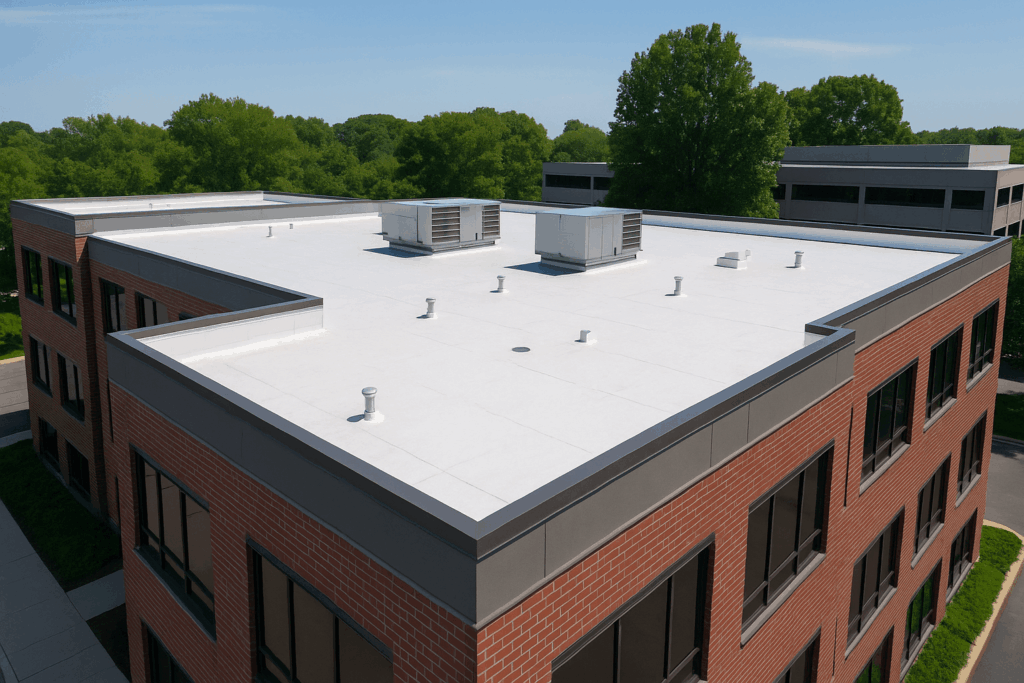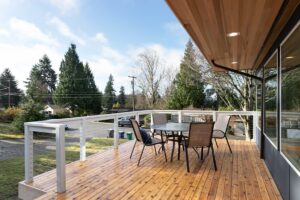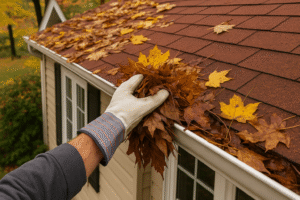If you’ve ever looked around Seattle, Bellevue, or any city in the Puget Sound region, you’ll notice one thing: almost every commercial building has a flat roof. But why?
The short answer: cost, practicality, and functionality. Flat roofs are easier to build, cheaper to maintain, and make it possible to place HVAC systems, solar panels, or even rooftop patios directly on top of your property. This blog breaks down the key reasons, plus what property owners should know about commercial flat roofing materials, maintenance, and costs.
Cost Efficiency – The Biggest Advantage
One of the main reasons commercial buildings have flat roofs is cost efficiency. By reducing material and labor requirements, flat roofing systems help businesses keep upfront expenses lower while also minimizing long-term repair and maintenance costs. This makes them a practical and economical choice for property owners across Puget Sound and beyond.
• Flat roofs require less material and labor than pitched roofs, making them more budget-friendly for large commercial structures.
• Popular flat roofing materials like TPO, EPDM, and modified bitumen are cost-effective while still durable.
• Long-term savings add up because maintenance and repairs are easier to manage compared to steep-slope systems.
Practicality for Mechanical Systems
One of the biggest reasons commercial buildings have flat roofs is the practicality they provide for mechanical equipment:
• Stable, accessible space for HVAC systems, solar panels, satellite dishes, and other mechanical units.
• Maximizes interior space by moving bulky equipment outdoors, freeing up valuable square footage for offices, retail, or storage.
• Easier servicing and replacement, since technicians can access rooftop systems without disrupting daily operations or tenants.
Energy opportunities, as flat roofs are ideal for solar panel installations and green roofing systems, helping businesses lower utility costs.
Flat roofs are essentially functional platforms. Instead of sacrificing ground or interior space, property owners can use the roof to house critical infrastructure — a huge advantage in dense urban areas where every square foot matters.
Ease of Maintenance and Access
Another reason commercial buildings have flat roofs is how simple they are to maintain compared to pitched systems:
• Safer, easier access for crews — flat roofs can often be walked on without scaffolding, steep harnesses, or special equipment.
• Lower inspection costs, since maintenance teams can complete routine checks quickly and efficiently.
• Early detection of issues, as flat surfaces make it easier to spot ponding water, membrane damage, or flashing problems before they worsen.
Extended roof lifespan, when paired with preventative care and timely repairs.
💡 Pro Tip: Regular inspections are the key to maximizing performance. Check out our guide on roofing maintenance tips to learn how proactive care can keep your commercial flat roof in peak condition for years.
The Modern Aesthetic of Flat Roofs
One of the often-overlooked reasons why commercial buildings have flat roofs is their sleek, modern appearance. Flat rooflines create a clean and minimalist profile that pairs well with contemporary architectural trends. In dense urban areas, this aesthetic is a major advantage for businesses that want their property to project a polished and professional image.
For commercial buildings in cities like Seattle, Bellevue, or Tacoma, the combination of style and practicality makes flat roofs a natural fit. They deliver not only functional benefits but also a contemporary aesthetic that reinforces a building’s identity and market value.

What Is the Best Material for a Commercial Flat Roof?
A common question property owners ask is: what is the best material for a commercial flat roof, and why do commercial buildings have flat roofs that often use different systems? The truth is, the right choice depends on your budget, building type, and long-term performance goals. Here’s a breakdown of the most popular options:
TPO (Thermoplastic Polyolefin):
One of the fastest-growing roofing systems in the U.S., TPO is energy-efficient, reflective, and cost-effective. It’s ideal for large commercial buildings that need both affordability and performance.
EPDM (Ethylene Propylene Diene Monomer):
Known as “rubber roofing,” EPDM has been trusted for decades. It’s highly durable, UV-resistant, and relatively low-maintenance, making it a great option for long-term reliability.
PVC (Polyvinyl Chloride):
PVC roofing membranes are resistant to fire, chemicals, and grease, which makes them a preferred choice for restaurants, industrial facilities, and manufacturing plants. While more expensive upfront, they offer exceptional durability in demanding environments.
Metal Roofing:
Though not as common for flat roofs, metal systems (such as aluminum or steel panels) are prized for their longevity. They have higher installation costs but deliver decades of performance with minimal maintenance.
Choosing the best material comes down to balancing initial investment with long-term savings, energy efficiency, and the specific demands of your building. That’s why many property managers consult with a trusted commercial roofing contractor in Puget Sound before making a final decision.
Meet our Commercial Roofing Page For More Information
How Much Does It Cost to Replace a Commercial Roof?
The cost varies depending on size, material, and building complexity:
• Average in Puget Sound: $8–$15 per sq. ft.
• Small buildings: ~$40,000+
• Large complexes: $250,000+ and up
👉 At Orca Roofing & Exteriors, we provide detailed commercial roof replacement estimates, premium materials, and in-house crews trusted by businesses across Puget Sound. Contact us today.
Final Thoughts: Why Do Commercial Buildings Have Flat Roofs?
At the end of the day, the answer to why commercial buildings have flat roofs comes down to a mix of cost savings, practicality, and design flexibility. From lowering upfront expenses to providing space for HVAC units and solar panels, flat roofing systems deliver both functional and financial advantages that sloped roofs simply can’t match.
But choosing the right flat roofing material and ensuring proper installation makes all the difference. A poorly installed system can lead to leaks, tenant complaints, and costly downtime. That’s why it’s essential to partner with an experienced commercial roofing contractor who understands the unique challenges of Puget Sound weather.
👉 At Orca Roofing & Exteriors, we specialize in commercial roof repair, replacement, and maintenance for businesses across Seattle, Bellevue, Tacoma, and beyond.
FAQs About Commercial Flat Roofs

Why do most commercial buildings have flat roofs?
Most commercial buildings have flat roofs because they are cost-efficient, practical, and versatile. Flat roofs use fewer materials, are faster to install, and provide space for HVAC units, solar panels, or other equipment. They also simplify maintenance and maximize usable interior space — key advantages for large commercial structures.
What type of roof is used in commercial buildings?
The most common commercial roofing systems are TPO, EPDM, PVC, and modified bitumen. These flat or low-slope systems are designed for durability, energy efficiency, and ease of maintenance, making them better suited for large-scale properties than traditional pitched roofs.
What is a flat commercial roof called?
A flat commercial roof is typically referred to as a low-slope roofing system. While not completely flat, these roofs have a slight pitch to allow for proper water drainage. Popular materials include TPO (Thermoplastic Polyolefin), EPDM (rubber roofing), and PVC membranes.
What is the disadvantage of a flat roof?
The main disadvantage of a flat roof is drainage. Because they have a very low slope, water can pool on the surface if not properly designed or maintained. Over time, ponding water may lead to leaks or membrane damage. Regular inspections and maintenance are essential to offset this risk.


